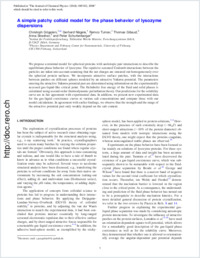A simple patchy colloid model for the phase behavior of lysozyme dispersions
- Gögelein, Christoph Institut für Festkörperforschung, Teilinstitut Weiche Materie, Forschungszentrum Jülich, Germany
- Nägele, Gerhard Institut für Festkörperforschung, Teilinstitut Weiche Materie, Forschungszentrum Jülich, Germany
- Tuinier, Remco Institut für Festkörperforschung, Teilinstitut Weiche Materie, Forschungszentrum Jülich, Germany
- Gibaud, Thomas Physics Department and Fribourg Center for Nanomaterials, University of Fribourg, Switzerland
- Stradner, Anna Physics Department and Fribourg Center for Nanomaterials, University of Fribourg, Switzerland
- Schurtenberger, Peter Physics Department and Fribourg Center for Nanomaterials, University of Fribourg, Switzerland
-
27.08.2008
Published in:
- The Journal of Chemical Physics. - 2008, vol. 129, no. 8, p. 085102
English
We propose a minimal model for spherical proteins with aeolotopic pair interactions to describe the equilibrium phase behavior of lysozyme. The repulsive screened Coulomb interactions between the particles are taken into account assuming that the net charges are smeared out homogeneously over the spherical protein surfaces. We incorporate attractive surface patches, with the interactions between patches on different spheres modeled by an attractive Yukawa potential. The parameters entering the attractive Yukawa potential part are determined using information on the experimentally accessed gas-liquid-like critical point. The Helmholtz free energy of the fluid and solid phases is calculated using second-order thermodynamic perturbation theory. Our predictions for the solubility curve are in fair agreement with experimental data. In addition, we present new experimental data for the gas-liquid coexistence curves at various salt concentrations and compare these with our model calculations. In agreement with earlier findings, we observe that the strength and the range of the attractive potential part only weakly depend on the salt content.
- Faculty
- Faculté des sciences et de médecine
- Department
- Département de Physique
- Language
-
- English
- Classification
- Physics
- License
-
License undefined
- Identifiers
-
- RERO DOC 11352
- DOI 10.1063/1.2951987
- Persistent URL
- https://folia.unifr.ch/unifr/documents/301011
Statistics
Document views: 225
File downloads:
- pdf: 159
